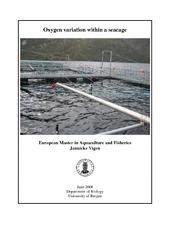| dc.description.abstract | In recent years, fish welfare during aquaculture production has received increasing attention, and it has been suggested that welfare is threatened as larger seacages are developed. Larger seacages with higher stocking densities are harder to control, thus knowledge of the physical chemical and biological processes that affect water quality is vital in order to ensure fish welfare. Information about the behaviour of the fish in relation to the environmental dynamics in various production systems is also essential. This thesis looks at the variation, particular to oxygen levels within a seacage and in relation to a reference point outside. The behaviour of Atlantic salmon was also investigated. Both a seacage in the cage environment laboratory at the Institute of Marine Research and a commercial salmon farm to obtain “real-life conditions” applicable to the farming industry were investigated. In addition to oxygen, temperature, salinity and current velocity were recorded. Fish behaviour, such as swimming depth, swimming speed and ventilation frequency was also investigated. An experimental setup was also done, where skirts were put around a seacage at Solheim, to study oxygen levels and fish behaviour during delousing treatment. The results demonstrate that salmon in an aquaculture situation are exposed to a highly variable environment, both physically and chemically, with large spatial and temporal variations of the environmental factors. Different levels of environmental stratification could be explained by the location of the farm (fjord site or a coastal site). The levels of oxygen within the seacages were related to the degree of stratification, water currents, stocking density, fouling and time of day. The interaction between the behaviour of the fish and environmental variation was demonstrated, such as the variations in natural light levels lead to a cyclic pattern in swimming depth, while feed attracted fish to the surface. In the skirt experiment, increased swimming speed and ventilation frequency was observed with decreasing dissolved oxygen levels, and was more pronounced when delousing treatment was added to the system, indicating that the treatment itself had an effect on the fish. | en_US |
